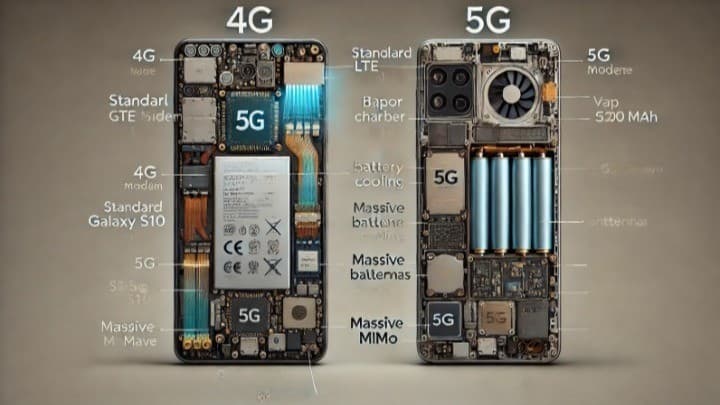Technological Evolution in Smartphones: Key Modifications in 5G Devices Compared to 4G Models
To understand the modifications in smartphones supporting 5G compared to those limited to 4G, I’ll use examples from Samsung’s Galaxy S series and iPhones, as these are benchmarks in the premium device market.
Key Modifications in 5G Smartphones Compared to 4G
The shift to 5G required significant changes across various hardware and software components, which I will detail below:
1. Modem and Chipset
- 4G Modem: In 4G smartphones, the integrated modem supports up to LTE Advanced Pro technology, allowing download speeds up to 1 Gbps using carrier aggregation and MIMO.
- 5G Modem: In 5G devices, the modem is significantly more advanced. It needs to support both Sub-6 GHz frequencies (below 6 GHz, similar to 4G) and mmWave frequencies (millimeter waves operating between 24 GHz and 100 GHz). Examples:
- Samsung Galaxy S10 (4G): Equipped with the Exynos 9820 modem (LTE).
- Samsung Galaxy S20 (5G): Equipped with Exynos 990 or Snapdragon X55, supporting 5G.
- iPhone 11 (4G): Uses the Intel XMM 7660 modem, limited to 4G.
- iPhone 12 (5G): Equipped with the Qualcomm X55 modem, supporting 5G.
- Chipset Changes: Supporting 5G requires a dedicated modem or one integrated into the SoC (System on Chip), increasing complexity and power consumption. Snapdragon 8xx and Exynos 9xxx chipsets in 5G versions integrate more powerful modems.
2. Antennas
- 4G Antennas: Typically, 4G smartphones use 2 to 4 antennas for LTE communication, designed to support lower frequency bands (700 MHz to 2600 MHz).
- 5G Antennas: The antenna design in 5G devices is much more complex, requiring support for both mmWave and Sub-6 bands. Millimeter waves need multiple antennas arranged in a Massive MIMO configuration, with up to 64 elements, to manage high attenuation and provide higher speeds. Examples:
- Samsung Galaxy S21 Ultra (5G): Features integrated mmWave antennas on the sides of the device.
- iPhone 12 Pro and 13 Pro (5G): Include mmWave antennas, visible on the sides of the device.
3. Cooling System
- 4G Cooling: 4G devices have lower thermal requirements since LTE modems consume less power compared to 5G modems.
- 5G Cooling: 5G smartphones, especially those operating on mmWave, generate more heat due to increased power consumption. Manufacturers have implemented more robust cooling systems, such as vapor chambers and enhanced heat sinks. Example:
- Samsung Galaxy S20 Ultra (5G): Uses a vapor chamber to dissipate the heat generated during continuous 5G use.
- iPhone 12 and 13: Improved thermal management with new heat dissipation systems to handle the demands of 5G.
4. Battery and Power Consumption
- 4G Devices: Typically have batteries ranging from 3000 mAh to 4000 mAh, with lower power consumption due to optimized LTE modems with reduced standby usage.
- 5G Devices: Feature larger batteries (up to 5000 mAh or more) to offset the high power demands of the 5G modem, especially when using mmWave bands. Power efficiency is a challenge, and devices employ intelligent algorithms to deactivate the 5G modem when not needed.
- Samsung Galaxy S20 Ultra (5G): 5000 mAh battery.
- iPhone 13 Pro Max: Battery optimized to handle 5G consumption, with a capacity of 4352 mAh.
5. Internal Space and Design
- Internal Space: Adding components to support 5G (such as multiple antennas and dedicated modems) requires more space within the device. This has led to changes in the internal layout and, in some cases, the removal of features like the headphone jack.
- Materials: Some 5G models feature designs optimized for better signal propagation, such as using less metallic materials on the side frames to avoid interference with mmWave antennas.
6. Software and Firmware
- 4G Software: 4G devices have optimizations for LTE and use carrier aggregation and MIMO algorithms to enhance speed.
- 5G Software: 5G devices include optimizations for switching between 4G and 5G networks, especially when the 5G signal is weak (which can sometimes provide a lower experience than 4G). They support DSS (Dynamic Spectrum Sharing), allowing simultaneous use of bands for LTE and 5G.
7. Frequency and Band Support
- 4G Frequencies: Supports frequency bands below 3 GHz.
- 5G Frequencies: Supports both Sub-6 GHz and mmWave bands. Sub-6 bands offer wider coverage, while mmWave bands are designed for high speed in densely populated areas.
- Samsung Galaxy S10: Supports LTE bands (up to band 71, 600 MHz).
- Samsung Galaxy S21 Ultra: Supports 5G bands like n78 (3.5 GHz) and mmWave (n260 and n261).
- iPhone 11: Limited to LTE.
- iPhone 12 and later models: Support both Sub-6 GHz and mmWave.
Practical Examples
Samsung Galaxy S10 (4G) vs Samsung Galaxy S20 (5G)
- Galaxy S10 (4G):
- Modem: Exynos 9820 (LTE)
- Antennas: 4G MIMO 4x4
- Cooling: Basic, without vapor chamber
- Battery: 3400 mAh
- Galaxy S20 (5G):
- Modem: Exynos 990 / Snapdragon X55 (5G)
- Antennas: Massive MIMO, mmWave support
- Cooling: Vapor chamber
- Battery: 4500 mAh
iPhone 11 (4G) vs iPhone 12 (5G)
- iPhone 11 (4G):
- Modem: Intel XMM 7660 (4G LTE)
- Antennas: Standard 4G LTE
- Cooling: Conventional
- Battery: 3110 mAh
- iPhone 12 (5G):
- Modem: Qualcomm X55 (5G)
- Antennas: Added mmWave antennas
- Cooling: Enhanced for 5G usage
- Battery: 2815 mAh (optimized for 5G)
Conclusion
5G devices not only add support for a new connectivity technology but also introduce significant changes in design, internal hardware, and software. The key modifications include new modems, specialized antennas, improved cooling systems, and larger batteries. These changes are necessary to handle the complexity and power requirements of 5G, while enabling much higher network speeds and capacities compared to 4G.
LinkedIn (in Portuguese): ![]()
